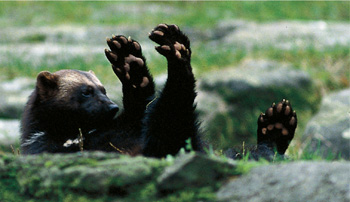
Gulo gulo
Wolverine tracks in the mountains. LAD.

The Wolverine, the largest European marten, is a powerfully built animal with short legs and a wide, flat head. It stands about 40–45 cm at the shoulder and is about 70–85 cm long. The tail is about 15–25 cm long. The female weighs about 10 kg; the male averages about 15 kg but may weigh up to, and sometimes more than, 25 kg. The Wolverine is not considerably larger than a Eurasian Badger.
With its thick dark fur, the Wolverine appears larger than it actually is. In the area around the eyes there is often a light, yellowish patch, and it has a yellowish stripe running from the shoulders to the tail. Unlike the hairs of dogs or wolves, those of a Wolverine don’t bunch together in a clump, even when the animal is wet. This is the reason the fur was once used for the cuffs of sleeves and edging of hoods on windbreakers.
The Wolverine lives in high mountain ranges and in high-elevation rugged wooded areas. It is territorial, marking the boundaries of its territory with scent secretions. Other than the mating season or when the female is raising young, the Wolverine is solitary. It does not hibernate, but rests in caves on rocky slopes, under large rocks, or in abandoned fox dens, or even digs a lair in a pile of snow at the bottom of a slope.
The Wolverine covers a wide area searching for food. Like other marten species, it moves with a jumping gait, and you normally find prints of all four feet. The normal stride is 60–120 cm, but when it walks or trots in snow, the Wolverine places the hind feet in or very close to the tracks of the front feet, reducing the length of its stride.
A Wolverine rolls on the ground to scratch its back. LS.

Wolverines have an excellent sense of smell. ME.

The Wolverine is an omnivore but will kill a wide range of prey including Reindeer, deer, sheep, small rodents, hares, frogs, birds, and larger insects. It readily consumes carrion, often carcasses left by Lynx or wolves. Wolverines will often cache the remains of larger animals. In late summer, Wolverines consume many berries.
The Wolverine caches food for winter. Just like Brown Bear, the Wolverine can chew the bark and branches off small trees, possibly also as a way to mark its territory.
The tracks are large, since the sole of the foot is covered with long, insulating hairs. Both the front and rear feet have five toes with long, powerful claws, but the imprint of the inner toe may sometimes be missing. The track can resemble that of a dog or small bear, though the toes usually form an arc in the front footprint. The front footprint is larger, at 12–16 cm long and 7–8 cm wide. Because the Wolverine lacks a heel pad, the rear footprints are narrower and shorter.
A Wolverine can climb like a bear. ME.

A sheep killed by a Wolverine. BW.

The twisted scat, up to 15 cm long and about 2.5 cm thick, often contain hairs and shards of bone. As is the case with the scat of other marten species, it is pointed at one end and left to mark territory. Unlike other marten species, the Wolverine does not use latrines.
